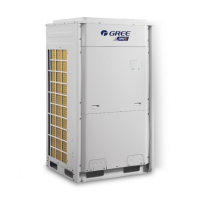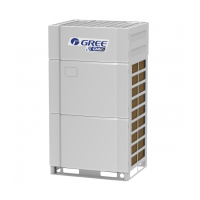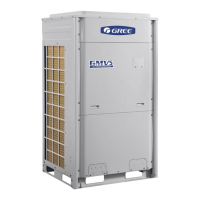GREE Photovoltaic Direct-driven Inverter Multi VRF Units
278
Step 13: System leak test
1) Check each welding joint for abnormalities. Observe each welding joint whether it is smooth and
doesn’t have obvious holes.
2) Then, charge high pressure nitrogen into the system for leak test. If you are only repair outdoor
units and are sure that indoor units are normal, you can charge nitrogen into the system of outdoor unit
only. Please note that nitrogen should be charged from both the high pressure side and low pressure
side. We recommend you to charge through all the big and small valves. Nitrogen pressure should be
larger than 20kgf. Then check the system with soapsuds, especially the welding joints.
3) Finally, charge high pressure nitrogen into the system again for pressure check. Close the big
and small valves and keep system pressure at 25kgf or higher for more than 12 hours. If pressure
remains unchanged during this period, you can extract the gas. Otherwise, find out the leak points.
While determining system pressure change, take temperature into consideration. For 1 ℃
temperature change, pressure will change by 0.01MPa accordingly. Suppose that nitrogen pressure
reaches 2.5MPa at 30℃, and 12 hours later, temperature decreases to 25℃ and pressure is found to be
above 2.43MPa accordingly, then the system is regarded qualified despite the pressure decrease.
Step 14: Fill lubricant
The amount of lubricant that is required to add is subject to the filling amount of compressor
lubricant as indicated in the specifications of outdoor unit.
For example:
For GMV-Y280WM/C-X units, one compressor is replaced. 4L of lubricant should be added into the
system, as required in the specifications of outdoor unit.
Specific procedure is as follows:
1) Photovoltaic direct-driven DC inverter units use FVC68D lubricant. Please confirm the trademark
of lubricant in the first place. Lubricant of other trademarks is not allowed.
2) Connect to all the big and small valves and evacuate for more than 30 minutes.
3) Connect a rubber hose to the oil charging valve. Open the container that holds lubricant and pour
lubricant into a measuring glass. If the glass is too small to hold the lubricant of a required amount,
measure the lubricant portion by portion. Record the volume of each portion and then put the other end
of rubber hose into the glass.
4) Keep on evacuating and meanwhile, open the oil charging valve. Lubricant will be pressed into
the low pressure side of the unit.
5) If the lubricant is added portion by portion, close the oil charging valve first and then measure
another portion of lubricant. In the course of repeated measuring and adding, keep evacuating.
6) After a required amount of lubricant is added, close the oil charging valve to ensure air tightness.

